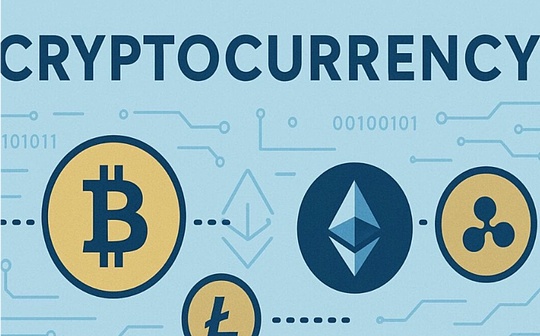
Author: Johnnatan Messias, Aviv Yaish, Benjamin Livshits Compiled by: Block unicorn
Airdrop is a common strategy used by blockchain protocols to attract and expand early user bases.Typically, the protocol distributes tokens to specific users as a “reward” for participating in the protocol in order to cultivate long-term community loyalty and ongoing economic activity.Despite the widespread presence of airdrops, there is a lack of in-depth understanding of the key factors for successful airdrops.This article outlines the design space for airdrops and proposes key results for implementing effective strategies.We evaluated their success by analyzing the on-chain data of six large-scale airdrops and found that a large number of tokens are often quickly sold by “airdrop farmers”.Based on these analyses, we summarize common pitfalls and provide guidelines for improving airdrop design.
Blockchain protocols often design reward programs to attract new users and enhance loyalty to existing users.In recent years, tokens minted by distribution platforms, commonly known as “airdrop”, have become widely popular.For example, in 2023 alone, the total value of airdrop tokens obtained by users through various protocols reached US$4.56 billion.Despite the widespread use of airdrops in the blockchain space, our preliminary research shows that there is no significant correlation between airdrops and the popularity of the platform relative to existing alternatives.Intuitively, this approach is not ideal and may lead to the loss of funds that could have been used to improve the platform’s quality of service (QoS).
Although the basic concept of airdrops is relatively simple, the design space for this type of reward scheme is very broad, and the specific implementation methods may vary according to the characteristics of the platform.For example, some airdrop mechanisms focus on “core users” and give them a lot of rewards, hoping that these users can stimulate valuable economic activities and thus attract more users.However, this approach can bring potential problems: When tokens give users the power to propose changes to protocols through decentralized governance, a “one token, one vote” strategy is often adopted, while a single user may hold multiple voting tokens.This raises the risk of centralization of voting rights, that is, a small number of users have the majority of decision-making power.
To understand why previous airdrops did not always meet the expected target and quantify their success, we first elaborate on a series of reasonable airdrop expectations.Next, we reviewed previous airdrops, evaluated their performance, and revealed some interesting insights in the process, comparing them to basic expectations.Specifically, we analyzed data from five popular airdrops (ENS, dYdX, 1inch, Arbitrum, Uniswap) and a fake airdrop performed by Sybil (witch attack) farmer (Gemstone).Our conclusion is that most of the tokens (up to 95%) were quickly sold through exchanges after airdrops, which shows that these airdrops failed to achieve their intended purpose, and the main beneficiaries were “airdrop farmers” – these highly professional users passedComplex strategies increase their share of tokens.Furthermore, we describe common challenges faced by airdrops in the past.Given that the airdrop phenomenon is relatively new and the understanding of its theory and practice is still in its early stages, previous airdrops may not be fully successful in the long run.Finally, based on the analysis, we put forward suggestions for improving the airdrop mechanism in order to create a more fair airdrop mechanism for honest users.
Block unicorn Note: The “airdrop farmers” referred to in the article automatically interacts through computer scripts or manually operates dozens of accounts. These are all defined as “airdrop farmers”.
Our contributions are summarized as follows:
▶Arbitrum Research
We conducted a comprehensive case study of Arbitrum airdrops by measuring elements such as transaction volume, token allocation structure, and token value before and after airdrops.We observed a significant increase in total daily expenses during the airdrop event.However, the number of transactions per address at Arbitrum dropped slightly after airdrop.In contrast, other protocols without airdrops performed better than Arbitrum.
▶Quantitative analysis
We conducted quantitative analysis of ENS, dYdX, 1inch, Arbitrum, Uniswap and a fake airdrop called Gemstone.The results show that most of the funds obtained through these airdrops are sold on exchanges rather than used to create dapps or user interactions on the platform.Of these, 36.62% of the ENS tokens were sold, dYdX was 35.45%, and 1inch was 54.05%.Typically, tokens are sold within an average of 1 to 2.34 transfers upon receipt, with a median of 2 transfers.
▶ Qualitative Analysis
We conducted a qualitative analysis of past airdrops and proposed guidelines for future airdrop design to address the issues we identified.We focused on airdrop farming behavior and the distribution of governance tokens through airdrops.To address these issues, we recommend other incentives, such as providing fee discounts for users’ subsequent interactions in blockchain protocols.
▶ Multi-chain empirical data
We collected data from two major Ethereum Rollup networks that were less studied in the literature—Arbitrum and ZKsync Era—and also collected and marked data from major airdrops.We plan to share our datasets and scripts in a publicly accessible repository.
Airdrop target
Airdrop is a powerful tool for promoting protocols, acquiring users, attracting new people and inspiring existing users to participate in these protocols and their applications.They are widely used for these purposes and there are many cases in the literature (see Table 1).The protocol can create tokens and distribute them to users via airdrops.For example, blockchain Rollup solutions such as Arbitrum, Optimism, and ZKsync Era, as well as DeFi applications such as Uniswap, 1inch, dYdX, and ENS, have used airdrops.
Airdrops can come in many forms, most commonly single and multi-round distribution.In a single round of airdrops, the tokens are distributed to users at one time, while multiple rounds of airdrops are distributed through multiple rounds, with different strategies per round.This approach can leverage previous rounds of insights to solve challenges, such as mitigating potential Sybil attacks (i.e. multiple accounts controlled by a single entity) by observing past user behavior patterns.Choosing a single or multiple airdrop depends on the goal of the agreement and the dynamics of the community.
In addition, the timing of airdrops has an important impact on the number of eligible users receiving tokens.Compared with new projects that are airdropped early, mature agreements may have a larger user base when airdrops are delayed.This difference in user base size introduces complexity when performing Sybil (witch attack) detection, as more accounts need to be evaluated and may require precautions.If the detection is not in place, it may affect community satisfaction, and the agreement may accidentally reward accounts related to industrial farming, which the community may have a negative view.To alleviate this problem, LayerZero Labs implements a self-report mechanism.Under this system, Sybil attackers can choose to self-report and claim their 15% share of token allocation.
Table 1, This table shows the start date, end date, blockchain, airdrop type, and project type of the six airdrop projects.
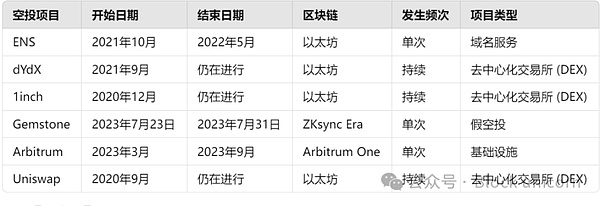
Next, we break down the high-level airdrop goal—the launching user community— into multiple sub-targets.These sub-targets are not independent of each other, and there may be other goals worth pursuing; we focus on these goals because they reveal interesting problems faced by common airdrop mechanisms.
Attract users in the short term.
Historically, airdrops have been used by emerging blockchain protocols to establish initial user groups and provide initial liquidity improvements for underlying chains and their protocols.Decentralized platforms, in particular, tend to become more attractive and valuable to users as economic activity increases, facilitating long-term participation.
It is important to start an initial user base, but it is not enough to maintain a long-term high level of economic activity.Ideally, users should become daily active users of the platform.This can be achieved by issuing rewards that can only be used in blockchain protocols or in-apps, similar to frequent flyer points for airlines.For example, in the Layer-2 blockchain, a fee discount can be provided for future transactions.Other measures that may be helpful include multiple rounds of airdrops and rewarding users who complete specific “tasks” that give users an in-depth understanding of the features provided by the protocol.For example, Linea’s airdrop mission provides users with an opportunity to experience its capabilities and use cases in depth.
Target users who create value for the platform.
Airdrops should focus on users who can contribute the most to the long-term sustainability of the platform.In a protocol that relies on users to provide liquidity, this may refer to users who provide the most liquidity to lending pools and decentralized exchanges, or users across multiple tokens.In Rollup, particularly valuable users may be the “creators” who deploy popular and useful smart contracts, or those who bridge tokens across chains to Rollup.This type of users provides additional usage scenarios for the platform, thereby attracting more users.
Post-trading market analysis
The motivation for quantitative analysis in this article is derived from the observation that the airdrop receiver usually sells tokens quickly and leaves in a short period of time, which obviously goes against the original intention of the airdrop.Analysis of decentralized exchange (DEX) airdrops shows that the recipient sometimes sells all of them shortly after receiving the token.For example, after ParaSwap airdrop, 61% of the tokens were quickly sold.
In both cases, most recipients stop using the relevant blockchain protocol within a few months.This pattern suggests that airdrops are ineffective in maintaining long-term participation of the recipient, or that there are a large number of Sybil accounts in the recipient.Furthermore, rapid sell-offs could disrupt the market, especially if the market sees it as a signal of a decline in confidence in the future prospects of the agreement.Here, we analyze data related to six airdrops (see Table 1) from node archive records for Ethereum, Arbitrum, and ZKsync Era (see Appendix 0.A for details on data collection).To identify the exchange, we used a list of 620 exchange account addresses obtained from Dune and Etherscan.
Table 2: Distribution statistics for six airdrops.Note that protocols usually send large amounts of airdropped tokens to addresses they control.For more information about the highest earners, see Table 4 in Appendix 0.D.
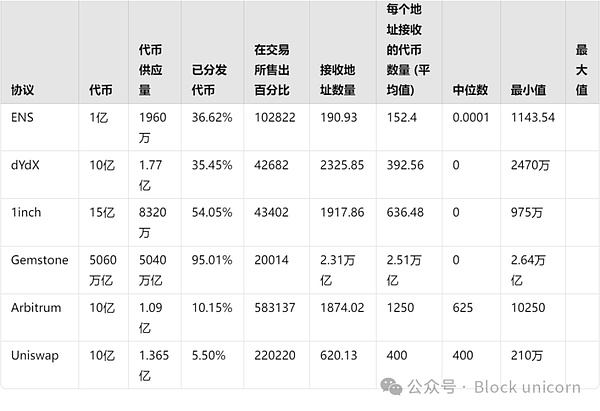
Token distribution time
Quantitative insights on the allocation of airdrop tokens among user groups are provided in Table 2.Our analysis reveals that there are a large number of receivers for each airdrop, suggesting that there may be airdrop farmers (see Table 2 Column 5).Furthermore, data shows that tokens are often traded on exchanges, which can be supported by the observation that the recipient’s first transfer after airdrop is often sold on exchanges (see Table 2 Column 4).The Gemstone case in particular is particularly prominent, with 95% of its tokens being sold on exchanges.In this Gemstone case, the airdrop was initiated by a non-open source decentralized exchange created by an airdrop farmers.
In addition, Gemstone airdrops far outweigh other airdrops in the number of tokens distributed.This large-scale distribution also results in a much higher median airdrop per recipient than other airdrops (see Table 2).It is worth noting that Gemstone allocated 99.53% of its total supply in its airdrop activity.It should be emphasized that Gemstone is mainly executed as a Sybil attack, not a legal airdrop.
Figure 1: Comparison of token claim and transfer patterns after airdrop: (a) Daily token claim; (b) Time required to arrive at the exchange.
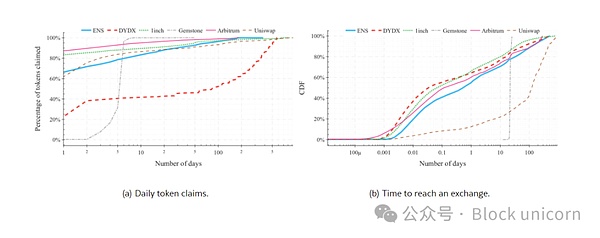
Of all the airdrops analyzed in this study, Arbitrum airdrop demonstrates the fastest user token claim.Figure 1(a) shows the account distribution of daily claim tokens.Arbitrum conducted a large-scale airdrop, distributing 1162166,000 ARB tokens to 625,143 selected accounts.Of these, 583,137 accounts (93.28%) successfully claimed 94.03% of the ARB allocation.It is remarkable that 72.45% of accounts completed token claim on the first day, and another 14.41% completed on the second day.Accumulated, almost 87% of accounts claimed Arbitrum’s tokens within the first day of the airdrop release, indicating that most participants were highly involved and acted quickly.
Table 3. Gemstone and 1inch are exceptions, with a median of 1 jump to the exchange, while other protocols show a median of 2 jumps to the airdrop receiver connecting to the exchange.
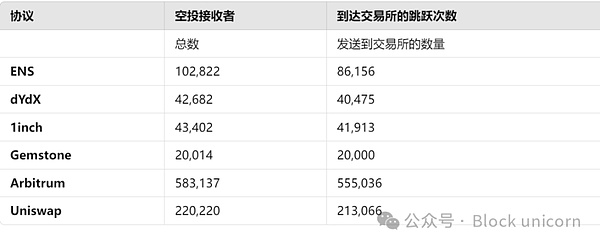
Users typically interact with exchanges to exchange one token for another or sell them.To evaluate the frequency at which airdrop recipients make profits by selling these tokens on exchanges after receiving them, we analyzed the user’s interactions on exchanges after airdrops.Table 3 shows that most airdrop receivers trade with the exchange, a proportion ranging from the lowest 83.79% for ENS to the highest 99.93% for Gemstone.
In addition, Table 3 also shows the shortest path from each airdrop receiving address to any exchange address in our dataset.Our research found that transferring tokens to exchanges usually involves only a few steps, suggesting that airdrop receivers have not made significant efforts to mask their activities.Gemstone is a notable exception, with all tokens being sold within a jump.Surprisingly, most accounts arrive at the exchange with relatively few intermediate steps (usually 2 jumps).This observation highlights the key role of exchanges in the cryptocurrency ecosystem.
Most accounts exchange their tokens within about one million blocks after airdrop.Due to the delay introduced by developers, Gemstone’s block count is significantly higher than other projects.Given that Ethereum (a new block is generated every 15 seconds) and ZKsync’s block generation time is different, we normalize the block time to days.As can be seen from Figure 1(b), 66.09% of 1inch accounts interacted with the exchange within one day.In comparison, ENS has an interaction rate of 55.15%, dYdX has 64.26%, and Arbitrum and Uniswap have 60.34% and 12.39%, respectively.This fast trading behavior is inconsistent with one of the main goals of airdrops in the protocol, which is to promote continuous participation by users. The rapid redemption of tokens indicates that the user may leave the protocol very quickly after receiving the airdrop.
Token allocation chart
To better understand the transfer structure that occurs when each address receives an airdrop token, we analyze the transfer network.Denoted as G(V, E), where each node (V) represents an address, and an edge (E) is created when the token is transferred from one address to another.Specifically, the ENS network contains 184585 nodes and 608462 edges, the dYdX network contains 112853 nodes and 406027 edges, the Gemstone network contains 20014 nodes and 240113 edges, and the 1inch network contains 308329 nodes and 1400913 edges.Arbitrum contains 2025898 nodes and 27438608 edges, and Uniswap’s network has 1180830 user addresses and 3762613 token transfer records.
To make these graphics easier to read visually, we limited the number of jumps in the data to one jump after receiving the protocol airdrop address and plotted their largest components within the first few hours after the airdrop.See Figure 7 in Appendix 0.B.We manually tagged nodes with high incoming degrees using tags provided by Etherscan, a popular blockchain browser.The results show that, except Gemstone, the decentralized exchange (measured in incoming) that received the most transfers in all protocols is Uniswap, followed by SushiSwap.
Figure 2: Number of daily active addresses for each protocol, (a) directly displays how many different users each platform has per day; (b) average the number of daily active users for each platform with the Arbitrum airdropComparisons allow us to see more intuitively the impact of airdrop activity on user activity.
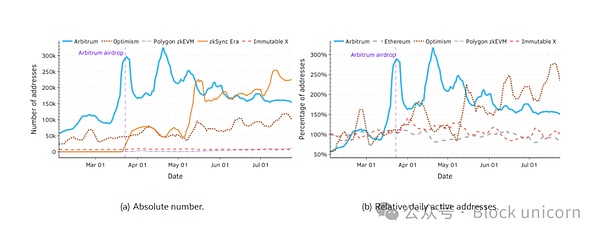
For Gemstone, all tokens are sent to the address 0x7aa⋯49ad in one jump.On the other hand, in dYdX airdrop, more diverse exchange addresses are used.It is worth noting that, as shown in Table 3, some airdrop receivers choose to sell their tokens on the exchange.We see some common exchanges like Uniswap, Wintermute and SushiSwap.
Figure 3: Daily transaction fees (USD), (a) Average fees per transaction.
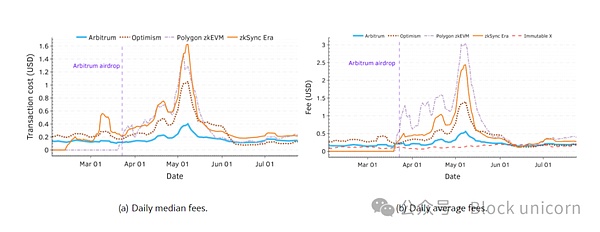
Measurement airdrop lift
Empirical research shows that some airdrops can successfully attract users in the short term, at least on the surface.While there are some preliminary data that airdrops have underperformed in achieving other goals, substantive research on this topic remains insufficient.In this section, we examine the performance of Arbitrum airdrops through some relevant indicators (such as daily trading volume, daily active addresses, median transaction fees, total locked value (TVL), fees paid by users, and stablecoin market value).The data we rely on is derived from Growthepie.See the appendix for more details on this data.
Unique active address
Very many protocols perform better without airdrops.Although Arbitrum’s number of unique addresses increased after airdrop and remained above 50% of the pre-airdrop level, other protocols achieved similar growth without airdrops.For example, Optimism achieved greater address growth in May 2023, which may be related to the launch of Bedrock.Similarly, ZKsync Era surpassed Arbitrum’s address count within two months of airdrop.
The cost may explain the narrowing of the gap between Arbitrum and Optimism.Arbitrum always leads Optimism in the number of active addresses per day.However, data show that the gap is narrowing.Before airdropping, Arbitrum had 2.6 times the number of active addresses than Optimism, but in the past 50 days, that has dropped to 1.83 times.Optimism’s lower median trading fees since June may partly explain this trend (see Figure 3(a)).
The number of unique addresses fluctuates over time.The number of unique addresses shows fluctuations, rising rapidly, and then falling after reaching peaks.It is worth noting that Optimism and Arbitrum exhibit opposite phases in relative address counts, which may be due to users switching between protocols when fees rise.However, there is no such model on median transaction fees, and Arbitrum’s fees are always low in mid-May 2023.However, this indicator of the number of unique addresses may be manipulated.According to our analysis, Arbitrum’s airdrops did not lead to long-term participation of users, as unique address metrics are easily manipulated.Users can create multiple addresses to take advantage of airdrop restrictions.This makes this indicator unreliable enough when measuring real activity, as large fluctuations may stem from such behavior.In addition, the ease of airdrop software makes the automatic execution of such activities more convenient.Therefore, other more Sybil-resistant metrics should be considered to evaluate real user engagement, such as incorporating graph network analysis and machine learning techniques.
Trading-related indicators
Trading-related indicators provide a useful alternative to measuring “real” economic activity, as users have to pay fees to send transactions, excluding protocols with retroactive kickbacks or operating at losses.
When considering transactions, the gap between Arbitrum and Optimism narrows.It is worth noting that by the end of July, the gap in the number of transactions between Arbitrum and Optimism was nearly narrowed.In addition, the daily transaction number of Immutable X has almost halved since Arbitrum’s airdrop, while its unique address number remains relatively stable (see Figure 4(b)).This shows that users’ participation in Immutable X has declined despite the stable number of addresses.
Figure 4: (a) shows the number of transactions per platform directly, and (b) compares the number of transactions per platform with the average before the Arbitrum airdrop, allowing us to see the airdrop activity more intuitivelyThe impact of transaction quantity.
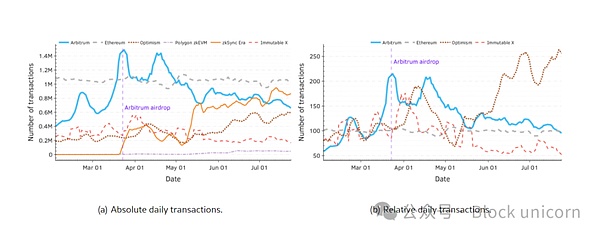
Arbitrum’s transaction volume drops after airdrop,To evaluate the impact of Arbitrum’s airdrop on user engagement in other protocols, Figure 5(a) shows the relative average daily transaction volume for each unique address.Arbitrum’s per-user transaction volume has dropped below 75% of the pre-airdrop level since the airdrop.However, transaction volumes can be misleading without considering fees, so relying solely on high transaction volumes does not necessarily reflect real user participation.In this regard, some protocols require users to make multiple transactions to obtain airdrops, which leads to an inflated activity when fees are low.This is consistent with the Goodhas Law, which states that “when an indicator becomes a target, it is no longer a good indicator.”
Figure 5: (a) Number of daily transactions; (b) Average daily transaction fees
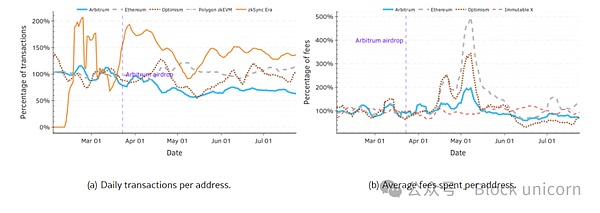
The average transaction fees for all agreements have been similar since June.A good indicator should reflect the user’s commitment, and transaction fees can act as a proxy because it measures the fees the user is willing to pay for interacting with the agreement.The average fees for each transaction for each agreement and for each unique address have been similar since June.Comparing average and median fees (see Figure 3) shows that median fees may be more helpful in understanding changes in user behavior.Another useful indicator is the relative average fee per address compared to the 50 days before Arbitrum airdrop, as shown in Figure 5(b).This suggests that Arbitrum’s user engagement is not significantly affected by airdrops and generally follows a pattern similar to other protocols.
Arbitrum’s total daily expenses surged during the airdrop period,Arbitrum’s airdrop did not give it a significant long-term advantage in terms of transaction fees, as shown in Figure 9.Although Arbitrum experienced a cost peak on the day of airdrop, the increase was short-lived.In fact, see Figure 6(a), Arbitrum’s daily transaction fees were 1.96 times higher than other protocols in the 50 days before airdrop, while this ratio narrowed to 1.74 in the last 50 days of the dataset.
Figure 6: (a) Daily transaction fee ratios for Arbitrum to Optimism; (b) TVL growth relative to the average of the Arbitrum airdrop for the 50 days before Arbitrum airdrop.
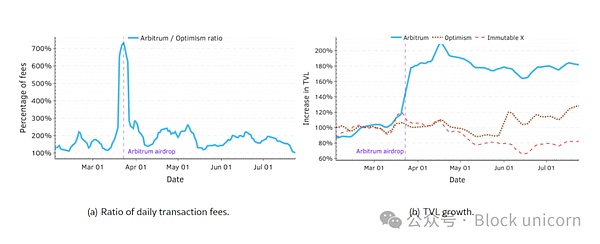
Total Value Lock (TVL),The TVL of the protocol is an indicator of the total value of all assets stored in the protocol.
Arbitrum’s airdrop had a lasting impact on its TVL, and of all the metrics examined, TVL was the only one that showed lasting improvement after airdrop:Arbitrum’s TVL increased by more than 50% immediately after airdrop and has not dropped significantly since then, as shown in Figure 6(b).This may be surprising, as Arbitrum’s airdrop distribution strategy only considers user activity until February 6, 2023.
Common airdrop design challenge
Airdrops are similar to traditional loyalty programs—such as new customer bonuses offered by banks and credit card companies—face several common design challenges.However, the unique background of blockchain technology and the specific mechanisms adopted by most airdrops may exacerbate these challenges and even introduce new ones.In this section, we explore three of these challenges.
Airdrop farmers
These are users who use complex strategies to maximize the number of airdrop tokens obtained.The blockchain protocol takes several measures to mitigate airdrop farmers’ manipulation of the system, and a common approach is to limit the number of rewards a single user can receive.
Therefore, the protocol shifts to Proof of Humanity (PoH) services, such as the Gitcoin passport.These services usually assign a numerical score to the user based on certain metrics. The higher the score, the greater the chance that the user is the real person.Gitcoin passport metrics are based on a range of tasks such as connecting users’ social media accounts, or holding a certain amount of ETH.These methods can be augmented by analyzing on-chain data to detect and exclude Sybil attackers, but this can lead to false negatives.
There are other mitigation techniques, such as requiring users to perform tasks, from sending some type of transaction, to sharing posts on social media.These tasks sometimes appear arbitrary, causing users to feel frustrated and prone to automation and cheap fraud, especially when the agreement provides feedback on transaction fees.Furthermore, the reliance of many protocols on a limited number of PoH services means that an investment by airdrop farmers can lead to a huge profit from multiple airdrops, and even with biometric authentication, there is no guarantee of complete Sybil resistance.
Another approach adopted by the agreement is to announce airdrops, retroactively rewarding users who are active before the announcement.However, farmers can prepare in advance, even if they interact with these protocols without formally announcing airdrops, as shown by dYdX’s airdrop.
Reward farming is not limited to encryption-related airdrops, but similar phenomena also occur in “traditional” loyalty programs.In particular, the practice of credit card farming is that users apply for credit cards only to get rewards from new users, and then cancel the credit card after receiving the reward.Given similar problems even in traditional environments where users can be easily identified and punished, the reward airdrop user problem does not seem to be easy to solve.
The threat of decentralized governance
Some protocols distribute governance tokens through airdrops to achieve decentralization of their governance process.However, there can be risks in distributing governance tokens.These tokens enable holders to participate in the governance of the agreement and make key decisions through voting.Often, these tokens can also be exchanged for other tokens, which may give them currency value, which may lead to more farmers getting these tokens.
Empirical evidence suggests that airdrop governance tokens may be better than non-government tokens.Recent analysis shows that airdrop governance tokens are up to 14.99% higher in terms of market capitalization growth rate than non-airdrop governance tokens.However, the authors also point out that this effect is not statistically significant when using common benchmarks.
Despite these potential benefits, airdrop governance tokens can pose significant risks if handled improperly.It may concentrate too much power in the hands of a few users, resulting in unfair distribution of decision-making power within the system.Furthermore, some recipients may not consider the best interests of the agreement and may change the agreement in order to their own interests through voting, thus causing damage to the long-term success of the agreement.
insider trading
This problem occurs when individuals use privileged information to seek economic benefits and harm the interests of users of other agreements.This practice is widely regarded as a violation of securities laws in traditional financial markets and often triggers negative reactions from the blockchain community.
When someone inside the agreement uses privileged information to increase his own profits, it can cause an objection from the community.Insiders may have an advance understanding of the metrics that determine eligibility and rewards per address and may utilize this information.For example, it was claimed that AltLayer’s growth chief might have used insider information to make $200,000 from airdrops, but it was later considered merely a coincidence.However, such events may weaken users’ trust in these protocols.
This issue also raises concerns about fairness, as some users have superior and more accurate information than others.Identifying these insider traders is a challenging task, so the protocol requires providing their users with detailed information.In addition, blockchain data analysis companies and research teams are incentivized to conduct post-airdrop data audits that can help identify insider traders by analyzing address details and transfer patterns.To achieve this, data availability is crucial.Therefore, the protocol should ensure transparency and encourage in-depth analysis to maintain integrity and equity in the blockchain community.
Design Guide
The aforementioned design challenges, while worrying, can provide inspiration for future airdrop designers and guide the path to potential success.
Alternative incentives to maintain user participation
The long-term benefits of airdrops for the protocol can be difficult to quantify, as potential advantages can be indirect and difficult to measure, while expenses are often immediate and irreversible.Furthermore, certain costs and impacts, such as the costs incurred by distributing governance tokens, may be unpredictable.Therefore, the community can consider adopting other measures to achieve a more predictable relationship between cost and benefit rather than using airdrops.An easy alternative is community voting procedurally reward loyal users for discounts on future interactions.In the context of a Tier 2 (L2) solution, these discounts can be applied to transaction fees.This approach encourages users to interact with the protocol again to benefit from the incentives and thus promotes ongoing user engagement.Furthermore, this incentive mechanism is relatively resistant to airdrop farmers, because the discount has no intrinsic value outside the agreement and the cost of the agreement is only for users who actively use the system.
However, the design of discount mechanisms must be cautious, including determining the user’s eligibility criteria and setting appropriate discount levels.Furthermore, it is unclear whether discounts can attract users as effectively as the instant and tangible rewards offered by airdrops.Another option is to do multiple airdrops over a longer period of time rather than a one-time event.While this approach may still face some of the pitfalls of standard one-time airdrops, it can help ensure long-term community engagement and prevent some protocols from experiencing a decline in user adoption immediately after airdrops.Blast has taken a more innovative approach to launching a points-based rewards program.Under this program, users accumulate points through multiple activities, thereby receiving rewards such as bridging tokens to protocols (i.e. transferring funds from another protocol) and participating in a recommendation program that adds more user points.It is worth noting that Blast received $1.1 billion in deposits before it was officially launched.This approach provides measurable metrics for users’ contribution to the protocol, structured around the recommendation plan model.
In addition, innovative allocation mechanisms play a crucial role in mitigating the existence of Sybil attacks in whitelist addresses.For example, Celestia proposes a unique design that uses GitHub submissions as a proxy to evaluate users’ contributions to the blockchain ecosystem.However, the concern that users or farmers may generate fake activities on GitHub to take advantage of airdrops from other protocols, adopting a similar strategy to Celestia.Therefore, farmers may expect the new agreement to use similar selection criteria as in the past airdrops.To cope with this, the protocol can focus on metrics that resist programmable manipulation, thereby increasing the difficulty or cost of creating an automated user account.
Targeted well-known and reputable entities
Instead of rewarding anonymous users, protocols can target developers and projects that are building related applications.For example, in Arbitrum’s airdrop, 1.13% of the tokens distributed are allocated to DAO projects.Arbitrum also provides additional incentives for specific groups in addition to airdrops, such as college students and tech community members who want to participate in research and develop tools related to the protocol.
Optimism implements another approach, distributing part of its revenue to successful projects for retroactive funding, essentially introducing the concept of entrepreneurship into the blockchain world.Prioritizing established and reputable entities, including projects, research groups, technical communities and students built on the agreement, can facilitate ongoing participation.By funding these entities, the agreement may attract value-driven users and facilitate long-term engagement.
Active supervision and community participation
During the airdrop process, it is crucial to continuously monitor and analyze protocol data to prevent malicious exploitation.For example, the Linea team discovered a vulnerability that allowed users to manipulate incentives.Timely discovery avoids cheaters from receiving more than one-third of the non-fungible tokens (NFTs) provided as incentives.
In addition to technical regulation, the agreement should encourage disclosure of vulnerabilities by maintaining open communication channels and providing vulnerability bounties, whether or not the vulnerability has been exploited.For example, a community member of AzukiDAO disclosed a vulnerability that enabled the protocol to be handled quickly.Regulation should also go beyond on-chain data.For example, social media is often exploited by scammers who steal users’ funds by promoting fake airdrops and tricking users into connecting their wallets to scam websites.Even if the agreement does not plan to do airdrops, it can be the target of such scams.
Active participation in technology discussions in the community can also help improve safety.For example, ZKsync Era’s NFT airdrop was retrospectively analyzed by cygaar and found potential cost-saving improvements.Maintaining transparency and providing the community with insights on how the protocol works internally can help build trust.When technical issues arise, fully informed users are more likely to respond with understanding.
Rewards should be linked to costs
The impact of Goodhart’s law is evident in many past airdrops.For example, airdrops usually actively participate in interactions by announcing rewards from users (it is best not to participate in these projects or projects that KOLs are calling everyone to participate).However, these methods can be abused and users may meet requirements through meaningless false transactions, thus making this standard unable to truly reflect the user’s true engagement.
The problem is that the operational metrics used to determine eligibility often fail to take into account the actual cost of the user for each operation.For example, when the number of transactions is the primary indicator, low transaction fees allow airdrop farmers to meet transaction volume requirements at extremely low costs.One potential solution is to adopt a reputation-based mechanism that can suppress the artificial expansion of transaction volume.However, the agreement must carefully define the “user reputation” and the appropriate metrics for evaluation.
Conversely, high transaction fees may weaken the value of rewards received by users and reduce the attractiveness of airdrops.To solve these problems, rewards should be adjusted according to the actual cost of the user to ensure that the allocation of incentives is more fair and effective.
Related work
Recent research on airdrops has focused on post-hoc analysis and guidance on designing effective airdrop activities.
Airdrop Research Yaish and Livshits proposed a theoretical model of airdrops, considering two groups of honest users and “airdrop farmers”, the latter has a lower space investment space cost and has a higher intrinsic utility from the platform using the issuing airdrops.Low.In their analysis, it is shown that when the issuer pays non-zero fixed costs for each recipient, the threat posed by a farmer’s false identity attack results in unlimited issuance costs.However, they also pointed out that losses from farmers can be limited by setting the total amount of airdrop tokens in advance and distributing them evenly to all recipients.Furthermore, by correctly designing airdrop mechanisms, farmers can be leveraged to promote network effects, thereby attracting honest users who might have chosen to compete on platforms.
Makridis et al. explore the impact of governance token airdrops on the growth of decentralized exchanges (DEXs).By analyzing 51 exchanges, they found that such airdrops significantly increased market capitalization and trading volume.Lommers et al. provide a comprehensive overview of various airdrop types such as base airdrop, coin-holding airdrop and value-based airdrop models.Their study points out how eligibility criteria, signaling and implementation strategies affect the success of airdrop activities and provides practical advice on optimization.Fan et al. conducted a case study on ParaSwap decentralized exchange and proposed a role classification based on user behavior and airdrop effect.Their research shows that users who receive higher rewards are more likely to contribute positively to the community.In addition, they identified arbitrage patterns and pointed out the limitations of the current method of detecting airdrop hunters.On the other hand, graph network analysis and machine learning methods are proposed for Sybil attack detection techniques used to solve these problems.
Allen conducted nine airdrop case studies (such as Optimism, Arbitrum, Blur) and provided insights on mission-driven pickup design.The study highlights the need for dynamic design and feedback loops, and points out that some projects may return to simpler designs due to the complexity and cost of advanced mechanisms.Allen et al. studied the motivation behind token airdrops, focusing specifically on its role in marketing and decentralization.Although airdrops are often seen as marketing tools, the authors consider this reason to be weak because there is limited evidence of success in marketing-driven airdrops.Instead, decentralization and community building are highlighted as the main motivations for airdrops.
Technical aspects of airdrop Frowis et al. identified the operational challenges and costs faced by large-scale airdrops on Ethereum.They suggest that with specific smart contract optimization, a cost savings can be saved by up to 50%, while a withdraw-based approach can be transferred to the recipient.But overall, the total cost is still proportional to the number of recipients.
Wahby et al. address privacy issues in current airdrop mechanisms that leak the recipient’s information.They propose a private airdrop scheme based on zero-knowledge proof, using RSA credentials to achieve privacy protection while maintaining computing efficiency.Their implementation significantly improves the speed of signature generation and verification.
in conclusion
This study identifies common problems in airdrops and proposes guidelines for improving their effectiveness.Our analysis of six major airdrop projects shows that it is common for recipients to sell their tokens quickly – 36.62%, 35.45% and 54.05% of the ENS, dYdX and 1inch tokens were traded shortly after distribution, andThe digits are only two transactions.This suggests that airdrops have failed to maintain long-term user engagement and have failed to attract valuable contributors.
For Arbitrum, we observed a surge in daily fees during airdrops, but with it a decline in transaction volumes per address.Other protocols that did not perform airdrops outperform Arbitrum, with transaction fees between protocols tending to be similar since June 2023, suggesting that airdrops are not the main driver of user growth.
Finally, we discuss challenges such as airdrop farmers, governance token distribution and insider trading, and provide insights into future airdrop strategies.




